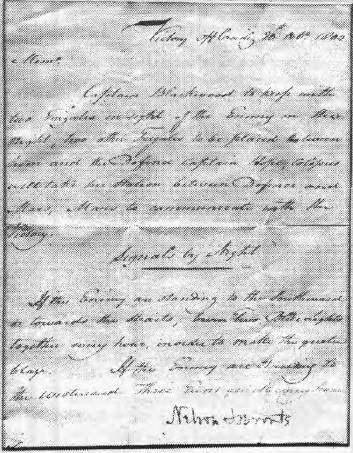- Author
- A.N. Other and NHSA Webmaster
- Subjects
- History - general
- Tags
-
- RAN Ships
- None noted.
- Publication
- September 1995 edition of the Naval Historical Review (all rights reserved)
In this “Australia Remembers” year, it is fitting to reflect on the 190th anniversary of the Battle of Trafalgar, and what “might have been” if Lord Nelson had been defeated by the combined fleets of France and Spain.
Providentially for Australia’s development, Britain achieved maritime supremacy, and the Royal Navy remained unchallenged for over a hundred years.
Nelson’s deeds are poorly enshrined in the annals of naval history and his example continues to inspire.
In a letter to the President concerning HMAS Sydney in the Mediterranean Commodore Ian Purvis observes “as for J. A. Collins and criticism about attacking two cruisers, that’s the first I’ve heard of it – A.B.C. doesn’t say so in “A Sailor’s Odessey”, as far as I’m aware – he had nothing but praise, and I’m sure Nelson would have approved. It was a classic example of the “combat supremacy” (to use Mahan’s phrase) bequeathed to us by the Lord Nelson, and as good a reason I know for continuing to commemorate Trafalgar Day“.
A former Captain of HMAS Penguin writes a memento which, as he says, provides a little known link with Nelson and the Battle of Trafalgar.
“In 1954 Ms. A. Trigg of Yass, NSW, presented HMAS Penguin with an original copy of Admiral Lord Nelson’s orders on the eve of the famous battle. What a masterpiece of clarity and brevity it was, compared with modern day Night and Operational Orders.
It read:-
“Victory”, Off Cadiz. 20th Oct. 1805. Memo
Captain Blackwood to keep with two frigates in sight of the Enemy in the night, two other Frigates to be placed between him and the “Defence“, Captain Hope. “Colossus” will take her station between “Defence” and “Mars“, to communicate with the Victory.
Signals by Night
If the enemy are standing to the Southward of towards the Straits, burn Two Blue Lights together every hour, in order to make the greater blaze. If the Enemy are standing to the Westward Three Guns quick every hour.
Nelson and Bronte It is understood that at least three copies of the orders were made by Nelson’s secretary, Mr. Scott, with Nelson signing each. On 20th October 1805, the Captains of Defence, Colossus and Mars came on board Victory and received orders. The original is believed to have gone to Captain Hope of the Defence who endorsed his copy after the battle as being authentic.
Neither Nelson nor Mr. Scott survived the battle, with Nelson’s body being returned to England where he lay in state in the Painted Hall of what is now the Royal Naval College, Greenwich, before burial in St Paul’s Cathedral.
The fate of Mr. Scott was reported on the front page of The Times and London Gazette of 7th November 1805, which gave the first detailed description of the Battle of Trafalgar to be published. It stated, inter alia, “When he saw his secretary and his friend Mr. Scott thrown overboard uncertain of the disfigurement of the wound and the confusion of the fight whether it was him or not he inquired with affectionate ardour “Was that poor Scott?” An impression seemed to be made on Lord Nelson for as men were carrying him down to the cockpit he said “Don’t let me be thrown overboard; tell Hardy to carry me home“.
Editor’s tailpiece: Captains D14 and D10 were on opposite sides of the line of destroyers screening a task force proceeding north from Alexandria in 1941. The Rear Admiral in Command started to signal his Night Intentions soon after lunch and they seemed interminable only ending at dusk. D14 made to D10:- “The road to Crete is paved with night intentions”! What a contrast with Nelson’s!





